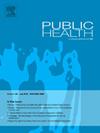Neighborhood environmental burden and chronic kidney disease in the US: A cross-sectional study
IF 3.2
3区 医学
Q1 PUBLIC, ENVIRONMENTAL & OCCUPATIONAL HEALTH
引用次数: 0
Abstract
Objectives
This study aims to analyze the association between overall environmental burden and chronic kidney disease prevalence in communities across the United States.
Study design
A cross-sectional study based on national neighborhood-level environmental burden and health data.
Methods
The study used data from 71,688 U S. census tracts from the Centers for Disease Control. We performed a mixed-effects linear regression model to analyze the association between the combined environmental burden and the prevalence of CKD. We analyzed whether there are differences or potential interactions in the association between environmental burden and CKD under different social vulnerability. We used the Boruta algorithm to analyze the association of different environmental indicators with the prevalence of chronic kidney disease.
Results
Neighborhoods with the highest environmental burden had a 0.377 % increase in the prevalence of CKD compared to neighborhoods with the lowest environmental burden ([95 %CI: 0.359, 0.395]; P < 0.001). This association remains significant after adjusted. The association between environmental burden and the prevalence of CKD is notably stronger in neighborhoods with the highest social vulnerability (β = 1.047 [1.028,1.065]; P < 0.001). A significant interaction (P < 0.001) between social vulnerability and environmental burdens was observed in this study. We found that air pollution was the most important variable for predicting CKD prevalence.
Conclusion
Our findings suggest that the higher cumulative environmental burden is associated with a higher prevalence of CKD in a dose-dependent manner. The strongest associations were observed in socially vulnerable neighborhoods.
美国社区环境负担与慢性肾脏疾病:一项横断面研究
目的本研究旨在分析美国社区总体环境负担与慢性肾脏疾病患病率之间的关系。研究设计:基于全国社区环境负担和健康数据的横断面研究。方法:该研究使用了美国疾病控制中心71688个人口普查区的数据。我们采用混合效应线性回归模型来分析综合环境负担与慢性肾病患病率之间的关系。我们分析了不同社会脆弱性下环境负担与CKD之间的关联是否存在差异或潜在的相互作用。我们使用Boruta算法来分析不同环境指标与慢性肾脏疾病患病率之间的关系。结果与环境负担最低的社区相比,环境负担最重的社区CKD患病率增加了0.377% (95% CI: 0.359, 0.395; P < 0.001)。这种关联在调整后仍然显著。环境负担与CKD患病率之间的相关性在社会脆弱性最高的社区中尤为明显(β = 1.047 [1.028,1.065]; P < 0.001)。本研究发现,社会脆弱性与环境负担之间存在显著的交互作用(P < 0.001)。我们发现空气污染是预测CKD患病率的最重要变量。结论:我们的研究结果表明,较高的累积环境负担与较高的CKD患病率呈剂量依赖关系。在社会脆弱的社区中观察到最强的关联。
本文章由计算机程序翻译,如有差异,请以英文原文为准。
求助全文
约1分钟内获得全文
求助全文
来源期刊

Public Health
医学-公共卫生、环境卫生与职业卫生
CiteScore
7.60
自引率
0.00%
发文量
280
审稿时长
37 days
期刊介绍:
Public Health is an international, multidisciplinary peer-reviewed journal. It publishes original papers, reviews and short reports on all aspects of the science, philosophy, and practice of public health.
 求助内容:
求助内容: 应助结果提醒方式:
应助结果提醒方式:


